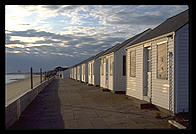
Camera Lens
by Philip Greenspun; revised January 2007
Home : Learn About Photography : Making Photographs : Camera Lens

by Philip Greenspun; revised January 2007
Home : Learn About Photography : Making Photographs : Camera Lens
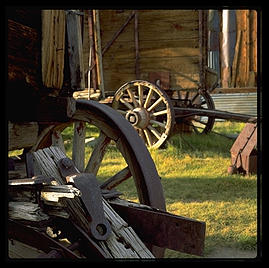
Once you've settled on the subject and the light, you have to decide on the relative prominence of objects in the scene. By moving the camera position back and forth, you can adjust the relative size of objects in the scene. After you're happy with the position, you pick a camera lens whose angle of view encompasses all the objects that you want to include in the photo.
Objects? Relative prominence? I only want to take a picture of my friend Cyrano! There is only one object in the scene and it is Cyrano's head.
Au contraire! The objects in this scene are Cyrano's nose, Cyrano's ears, and Cyrano's eyes. Suppose that you position your camera 10" from Cyrano's eyes. If his nose sticks out 5" in front of his eyes, then it will be only half the distance from the camera as the eyes and therefore relatively more prominent. Stretch out your arm right now and compare the size of your index finger to the lines of text on the monitor. Only about as big as a paragraph, right? Now close your left eye and bring that same finger in until it is just in front of your nose. Note that your finger appears taller than the entire monitor.
Aesthetic tip from MIT: when your nose sticks out 5" in front of your eyes, you don't want it to appear relatively more prominent.
Suppose that you actually want this photo as the "before" illustration in a plastic surgeon's advertisement. Well, then haul out the 24mm wide angle lens and you can have a complete portrait taken from 10" away.
Suppose that you wish to flatter Cyrano. You'll want to back up until you are separated by the length of a football field. Now his nose is still 5" closer to the camera but that is 5" out of 100 yards (note for European readers: 100 yards is just short of half a standard furlong.) So instead of being 50% of the distance to the camera as Cyrano's eyes, the nose is 99.86% of the distance away. It will not be significantly more prominent.
What about the 24mm lens from this camera position? It will give you a nice photo of the entire stadium and the city behind it. Cyrano's face will appear as a portion of a grain of silver on the film. You're now 100 yards away from Cyrano so you will need the Mother of All Telephoto Camera Lenses. In fact, according to the formulas in my Kodak Professional Photoguide, if Cyrano's face is 12" high, you will need a 7500mm lens to fill the frame with it. Cyrano will be flattered but considering that a Canon 600mm lens costs almost $10,000, the effect on your wallet will not be a happy one.
Apologies to people from countries that have adopted sensible units.
In a perfect world, you would leave the house with only a Canon 14 super-wide lens. You would worry only about camera position, secure in the knowledge that the 14mm lens was wide enough to capture the entire subject under 99% of conditions. Then if you wanted a picture of just a friend in the middle of the frame, you'd crop down to just the center and use that. The result would be the same as if you'd used a 100mm portrait lens.
The reason this doesn't work is that lenses and sensors aren't perfect. If you throw away 98% of the area of the digital sensor (and/or make a huge enlargement), you can expect to have some pretty crummy looking pixels. So if you're sure at exposure time that you will want more magnification, it is best to carry some higher magnification camera lenses.
The rest of this article discusses what kinds of camera lenses we might want to lug around.
With a full-frame digital SLR or 35mm film, a wide angle lens is generally considered anything with a focal length of 35mm or less.
Here are a couple of snapshots taken with an ancient Canon 20-35/2.8L zoom lens. Note that the image on the left, at 20, appears to be significantly distorted if you view it from far away. But try clicking on it so that you get a monitor-filling JPEG. Then move your face in close to the monitor so that you are viewing it from a few inches away. The distortion disappears, right? A wide angle lens does not distort perspective but, if the viewer of the ultimate image does not adjust his viewing position, it appears to do so.
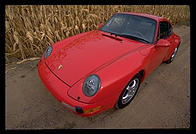
|
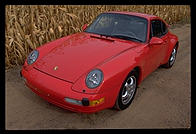
|
| at 20 (camera closer to car) | at
35 (camera farther from car) |
|---|
As a practical matter, most people these days aren't impressed by a wide-angle effect until you get down to 24mm. Wide angle camera lenses start to get expensive at 20mm ($500) and wider. So good compromises these days are are probably a fixed 24 ($250) or a high-quality 16-35 zoom ($1500). See the Canon and Nikon web sites for an idea of what's available (Sony makes great lenses, but they haven't been doing it for as many years so there aren't as many choices.)

A "normal" or "standard" camera lens is one that produces prints with no apparent wide angle or telephoto distortion. In other words, when viewed at a standard distance, a print taken with a normal lens will appear to have no unusual perspective. For a camera taking 35mm film, a 50mm lens is considered normal.
Normal lenses are easy and cheap to fabricate. A 50/1.8 costs under $100 and will optically outperform most of the lenses in any manufacturer's line. Furthermore, normal camera lenses allow photography in rather low light with no flash or tripod. A yuppie with a mid-range zoom lens has a maximum aperture of f/4. A photographer with a 50/1.8 not only saves $200 but is gathering 4 times as much light (2 f-stops). With a standard single-lens reflex (SLR; viewing through the lens), this makes viewing and composition easier because the viewfinder is 4 times brighter.
If you don't feel like saving $200, you can get a 50/1.4 which will gather another factor of 2 in light. If you are a real wastrel, you can splurge $2500 on a lens like the discontinued Canon 50/1.0. This gathers 16 times as much light as a typical mid-range zoom.
Another common option is the 50mm macro lens. I refer you to my article on macro photography and my review of the Nikon 60/2.8 AF lens.
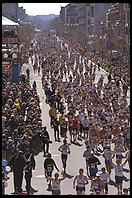
Telephoto lenses are high-magnification devices. These are for when you are photographing something from far away either because you want to flatten perspective or because you are unable to approach your subject.
It is difficult and expensive to produce a high-quality telephoto lens. In fact, only in the last couple of decades have manufacturers been able to design really high quality 300mm and longer camera lenses.
Telephoto lenses can be useful for portraits, most often in the 85-180mm
range. Photography of large animals is facilitated by 300-600mm
lenses. Photography of birds starts with a 600mm lens and goes up from
there.
Telephoto camera lenses that serious Canon EOS photographers buy include the following:

There are equivalents for all of these in the Nikon system and equivalents for some for Sony users.
A teleconverter is a small lightweight intermediate optic that will increase the magnification of a lens, while reducing its effective aperture. So a 2X teleconverter turns a 300/2.8 into a 600/5.6. A lot of times new photographers ask me if they can save money by buying a teleconverter and sticking it onto their 28-70 zoom to get a 140mm lens. Sadly, good teleconverters cost $400 or $500 and they only work optically on expensive lenses. With a typical zoom lens, you'll get vignetting (darkening of the corners) when using a teleconverter.
Teleconverters are for professionals who own expensive lenses and want to save weight by not carrying two lenses. They are also useful sometimes with specialized tilt-shift lenses so that you don't have to buy these in lots of different focal lengths.
Why carry around a whole bag of fixed focal length ("prime") lenses when you could just buy a 10:1 superzoom, e.g., 28-300, for less than $400? The problem with this idea is that the laws of physics and common sense have not been repealed.
Photographic lenses in general are not very good. They only appear to be good because people very seldom enlarge or closely inspect images. Camera lenses are subject to many kinds of distortion, all of which are more difficult to reduce in a zoom lens design. Furthermore, zoom lenses tend to be slower (admit less light) than prime lenses. This forces the photographer into using flash and/or a tripod.
Does that mean you shouldn't buy a zoom lens? Absolutely not. The average Canon EOS photographer will own three beautiful zoom lenses: 16-35, 24-70, 70-200/2.8. These are a great convenience for the lazy and/or pressed-for-time photographer. However, none of these are as good as prime lenses in their focal length range. Each of these zooms costs over $1,000, so they won't help you out if you don't like the prices of the prime lenses.
See my review of the Canon 15mm fisheye lens.
As far as I know, Canon is the only company in the world that makes a lens intended for convenient photography of objects smaller than the film or digital sensor. See my review of the Canon MP-E 65mm 1X-5X macro lens.
Modern digital cameras produce extremely high quality images. In reasonable lighting conditions, the limiting factor in the quality of your image will almost always be the lens. If you want to achieve a good result, you must have the correct lens for the job and it must be a high quality example of that kind of lens.
Lots of companies make high-quality lenses. Sadly, none of them have figured out how to break physical laws and do so cheaply. So if your creative goals require a long telephoto or very wide angle lens, prepare to cough up the big bucks. If you are using a larger format than "full-frame 35mm" (24x36mm sensor), prepare to cough up the big bucks for any lens!
If you own a popular DSLR or mirrorless system, you should be able to rent lenses (or even a medium-format body). It will definitely expand your creative horizons without breaking you financially. There are a variety of commercial mail order gear rental services. KitSplit is an interesting peer-to-peer system that has some exotic stuff, e.g., large format view camera systems.
Remember when using a large or medium format camera that a given lens focal length will result in a different perspective than on a 35mm camera. Use this table to convert.
Next: Film.